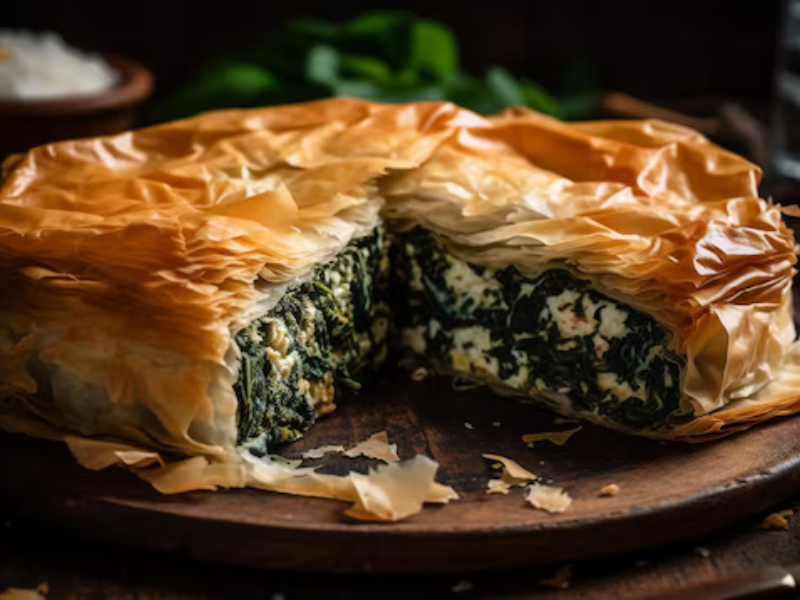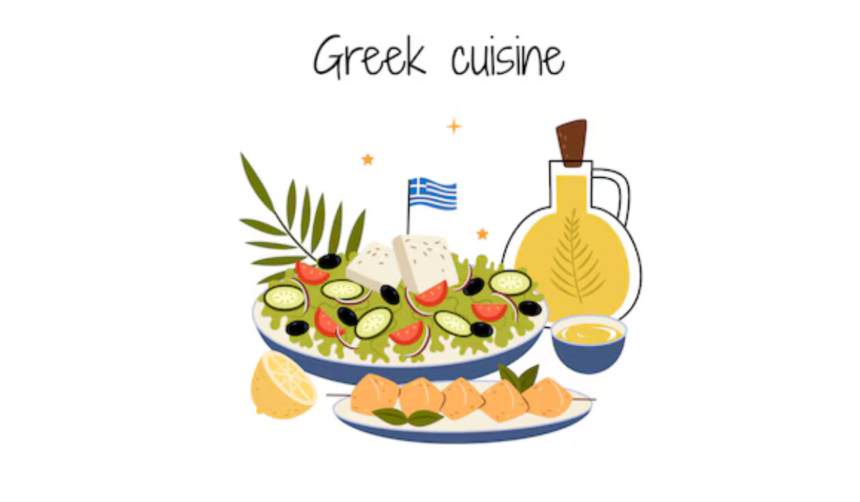A Taste of Greece: Exploring the Rich Flavors of Greek Cuisine
From feta cheese to olives, Greek cuisine is known for its delicious and diverse flavors. With a history that dates back thousands of years, Greek cooking is a fusion of Mediterranean influences that have been passed down through generations. Whether you’re indulging in a traditional meze platter or savoring a hearty moussaka, each bite transports you to the sunny shores of the Greek islands. In this article, we will explore the rich flavors of Greek cuisine and discover the secrets behind some of its most iconic dishes.
1. The Mediterranean Diet: A Foundation of Greek Cuisine
The Mediterranean diet is widely regarded as one of the healthiest in the world, and Greek cuisine is at its heart. With an emphasis on fresh fruits and vegetables, whole grains, olive oil, and lean protein, the Mediterranean diet is not just about what you eat, but how you eat. Meals are meant to be enjoyed slowly, with family and friends, in a relaxed and social setting. This focus on fresh, high-quality ingredients and mindful eating is key to the deliciousness of Greek cuisine.
2. Olive Oil: The Liquid Gold of Greek Cooking
Olive oil is a staple in Greek cooking and is used in almost every dish. Known as liquid gold, Greek olive oil is prized for its rich flavor and health benefits. Whether drizzled over a salad, used to sauté vegetables, or as a dip for bread, olive oil adds a distinctive taste to Greek cuisine.
3. Feta Cheese: The King of Greek Cheeses
Feta cheese is one of the most famous Greek cheeses and is a key ingredient in many traditional dishes. Made from sheep or goat milk, feta is tangy, salty, and creamy, giving Greek salads and pastries their signature flavor. Whether crumbled over a salad or baked into a spanakopita, feta cheese is a versatile ingredient that adds a rich depth of flavor to any dish.
4. Meze: The Art of Small Plates
Meze is a popular way of dining in Greece, where a variety of small plates are served as appetizers or snacks. From tzatziki and hummus to dolmades and grilled halloumi, meze dishes showcase the best of Greek flavors. Meze is often enjoyed with a glass of wine or ouzo, and is a great way to sample a range of flavors and textures in one meal.
5. Souvlaki: The Greek Street Food Staple
Souvlaki is a beloved Greek street food that consists of skewered and grilled meat, usually served with pita bread, tzatziki, and vegetables. Whether it’s pork, chicken, or lamb, souvlaki is a quick and delicious meal that can be enjoyed on the go. The smoky flavors of the grilled meat, paired with the cool and creamy tzatziki, make souvlaki a must-try when in Greece.
6. Moussaka: A Hearty and Comforting Dish
Moussaka is a classic Greek dish that consists of layers of eggplant, ground meat, and béchamel sauce, baked to golden perfection. This hearty and comforting dish is a staple of Greek cuisine and is often served at family gatherings and celebrations. The flavors of cinnamon, nutmeg, and allspice in the meat mixture, combined with the creamy béchamel topping, make moussaka a true taste of Greece.

7. Spanakopita: A Flaky and Savory Delight
Spanakopita is a traditional Greek pastry made with layers of phyllo dough, spinach, feta cheese, and herbs. This flaky and savory dish is a popular appetizer or snack in Greece and is often enjoyed with a Greek salad or meze platter. The combination of the buttery phyllo dough, earthy spinach, and tangy feta cheese makes spanakopita a delicious and satisfying treat.
8. Baklava: A Sweet and Sticky Dessert
Baklava is a decadent Greek dessert made with layers of phyllo dough, nuts, honey, and spices. This sweet and sticky treat is a favorite at Greek celebrations and holidays, and is often enjoyed with a cup of strong Greek coffee. The crunchy layers of phyllo dough, nutty filling, and syrupy sweetness make baklava a must-have dessert for anyone with a sweet tooth.
9. Greek Coffee: A Strong and Aromatic Brew
Greek coffee is a traditional coffee drink that is made by boiling finely ground coffee beans with water and sugar. The result is a strong and aromatic brew that is enjoyed throughout Greece. Served in a small cup, Greek coffee is often paired with a sweet treat, like baklava or loukoumades, and is a great way to end a meal or take a break during the day.
10. Ouzo: The Anise-Flavored Spirit of Greece
Ouzo is a popular Greek spirit that is distilled from grapes and flavored with anise. This clear and potent drink is often enjoyed as an aperitif or digestif, and is typically served with a few ice cubes and a splash of water. Ouzo has a distinct licorice flavor that pairs well with meze dishes, and is a staple at Greek celebrations and gatherings.
11. Gyro: The Perfect Fast Food
Gyro is a popular Greek street food that consists of thinly sliced meat, usually pork, chicken, or lamb, wrapped in pita bread with tzatziki, tomatoes, onions, and lettuce. This portable and delicious meal is a favorite among locals and tourists alike, and is a great option for a quick and satisfying lunch or snack. The combination of tender grilled meat, tangy tzatziki, and fresh vegetables make gyro a must-try when in Greece.
12. Greek Wine: A Heritage of Flavors
Greece has a long and storied history of winemaking, dating back thousands of years. With over 300 indigenous grape varieties, Greek wine offers a wide range of flavors and styles that reflect the diverse terroir of the country. From crisp and refreshing whites, like Assyrtiko, to bold and spicy reds, like Xinomavro, Greek wine is a perfect complement to the rich and savory flavors of Greek cuisine.
13. Loukoumades: The Greek Donut
Loukoumades are a popular Greek dessert that consists of deep-fried dough balls, drizzled with honey and sprinkled with cinnamon and nuts. These sweet and crispy treats are often enjoyed at festivals and celebrations in Greece and are a favorite among locals and tourists alike. The combination of warm dough, sticky honey, and fragrant spices makes loukoumades a delicious and indulgent dessert.
14. Yemista: Stuffed Vegetables Bursting with Flavor
Yemista is a traditional Greek dish that consists of hollowed-out vegetables, like tomatoes, bell peppers, or zucchini, stuffed with a mixture of rice, herbs, and spices. Baked until tender and golden, yemista is a flavorful and satisfying dish that showcases the best of Greek produce. Whether enjoyed as a main course or as a side dish, yemista is a delicious and nutritious option for any meal.
15. Pastitsio: A Greek Twist on Baked Pasta
Pastitsio is a Greek pasta dish that consists of layers of macaroni, ground meat, tomato sauce, and béchamel sauce, baked to perfection. This hearty and comforting dish is often enjoyed at family gatherings and holidays, and is a favorite among both children and adults. The warm and creamy layers of pasta, meat, and sauce make pastitsio a classic taste of Greece that is sure to satisfy any appetite.
In conclusion
Greek cuisine is a celebration of fresh, high-quality ingredients, rich flavors, and centuries-old traditions. From meze platters to street food staples, Greek cuisine offers something for everyone to enjoy. Whether you’re a fan of savory moussaka or sweet baklava, there’s no shortage of delicious dishes to discover in Greece. So next time you sit down to enjoy a Greek meal, savor each bite and take in the flavors of the Mediterranean that have been passed down through generations. Opa!
FAQs about “A Taste of Greece: Exploring the Rich Flavors of Greek Cuisine”
- What defines Greek cuisine, and what makes it unique? Greek cuisine is characterized by its use of fresh, local ingredients, Mediterranean flavors, and simple cooking techniques. It emphasizes the importance of olive oil, fresh herbs like oregano and mint, and ingredients such as feta cheese, olives, and yogurt. What makes Greek cuisine unique is its ability to showcase the richness of flavors while maintaining a focus on healthfulness and seasonality.
- What are some essential ingredients in Greek cooking, and where can they be found? Essential ingredients in Greek cuisine include staples like olive oil, garlic, tomatoes, and phyllo dough. Greek herbs like oregano, thyme, and rosemary are also fundamental to many dishes. You can find these ingredients in most grocery stores, but for a wider selection and authenticity, consider visiting specialty Mediterranean markets or sourcing from Greek producers online.
- Are there vegetarian or vegan options within Greek cuisine? Yes, Greek cuisine offers a variety of vegetarian and vegan options that are both delicious and nutritious. Dishes like spanakopita (spinach pie), fasolada (bean soup), and horiatiki salad (Greek salad) are popular choices. These dishes highlight the abundance of fresh vegetables, legumes, and grains in Greek cooking, making it easy to enjoy a plant-based diet while exploring Greek cuisine.
- How can I recreate Greek dishes at home if I’m not familiar with the cuisine? Recreating Greek dishes at home can be a delightful experience, even for beginners. Start by experimenting with classic recipes such as moussaka (eggplant casserole), souvlaki (grilled meat skewers), or tzatziki (cucumber yogurt dip). Many online resources, cookbooks, and cooking shows offer step-by-step instructions and helpful tips to guide you through the process. Don’t hesitate to explore different Greek ingredients and flavors to tailor the dishes to your preferences.
- Are there any cultural aspects or traditions associated with Greek cuisine? Greek cuisine is deeply rooted in tradition and culture, often serving as a centerpiece for gatherings and celebrations. Meals are typically enjoyed slowly, with family and friends, fostering a sense of community and togetherness. Traditional Greek cooking methods, such as baking in clay pots or grilling over open flames, have been passed down through generations, preserving the authenticity of Greek flavors. Additionally, certain dishes hold symbolic significance during religious holidays and festivals, reflecting the rich cultural heritage of Greece.
Advantages:
- Cultural appreciation: The title suggests an exploration of Greek cuisine, promoting cultural appreciation and understanding among readers.
- Culinary diversity: Greek cuisine offers a rich variety of flavors, ingredients, and dishes, providing readers with a diverse culinary experience.
- Gastronomic adventure: Readers can anticipate embarking on a culinary journey through the flavors of Greece, discovering new tastes and textures along the way.
- Educational value: Exploring Greek cuisine provides an opportunity for readers to learn about the history, traditions, and cultural significance of various Greek dishes.
- Inspiration for cooking: The title may inspire readers to try their hand at cooking Greek dishes at home, expanding their culinary repertoire and experimenting with new flavors.
Disadvantages:
- Generalization: The term “Greek cuisine” encompasses a broad range of culinary traditions across different regions of Greece, potentially oversimplifying the diversity within Greek cooking.
- Lack of specificity: The title does not specify which aspects of Greek cuisine will be explored, leaving readers uncertain about the focus or depth of the content.
- Potential cultural appropriation: Without proper context and respect for the origins of dishes, exploring Greek cuisine could risk appropriating cultural elements without understanding their significance.
- Accessibility: Some ingredients and cooking techniques in Greek cuisine may be challenging to find or replicate for readers outside of Greece, limiting the practicality of the exploration.
- Dietary restrictions: Greek cuisine often includes ingredients like dairy, seafood, and grains, which may not be suitable for individuals with dietary restrictions or preferences, potentially alienating some readers.
















